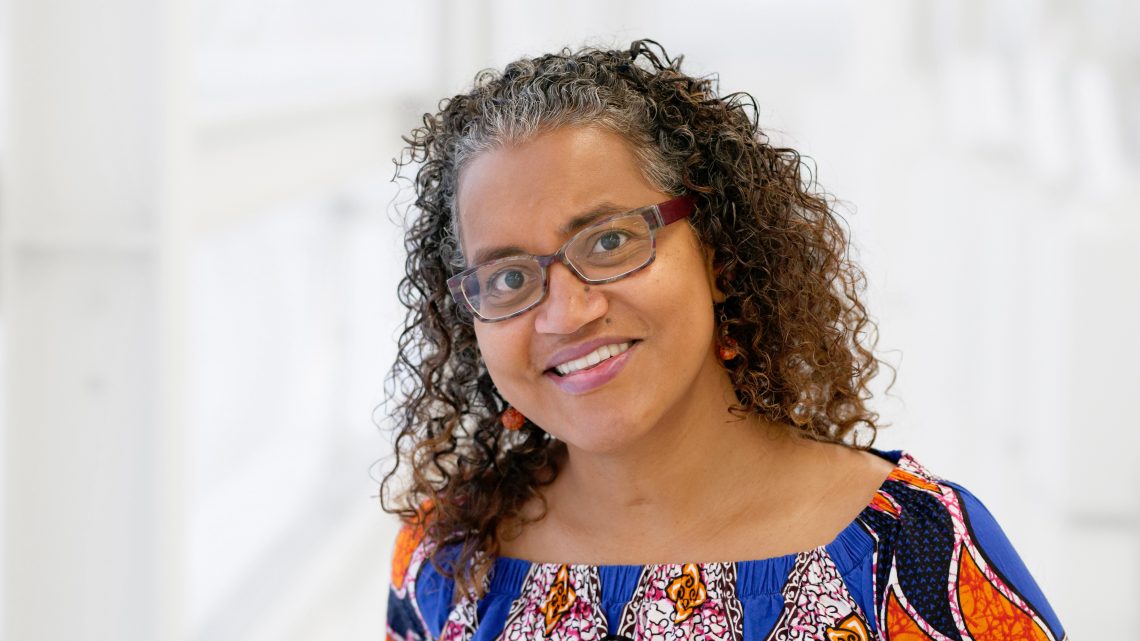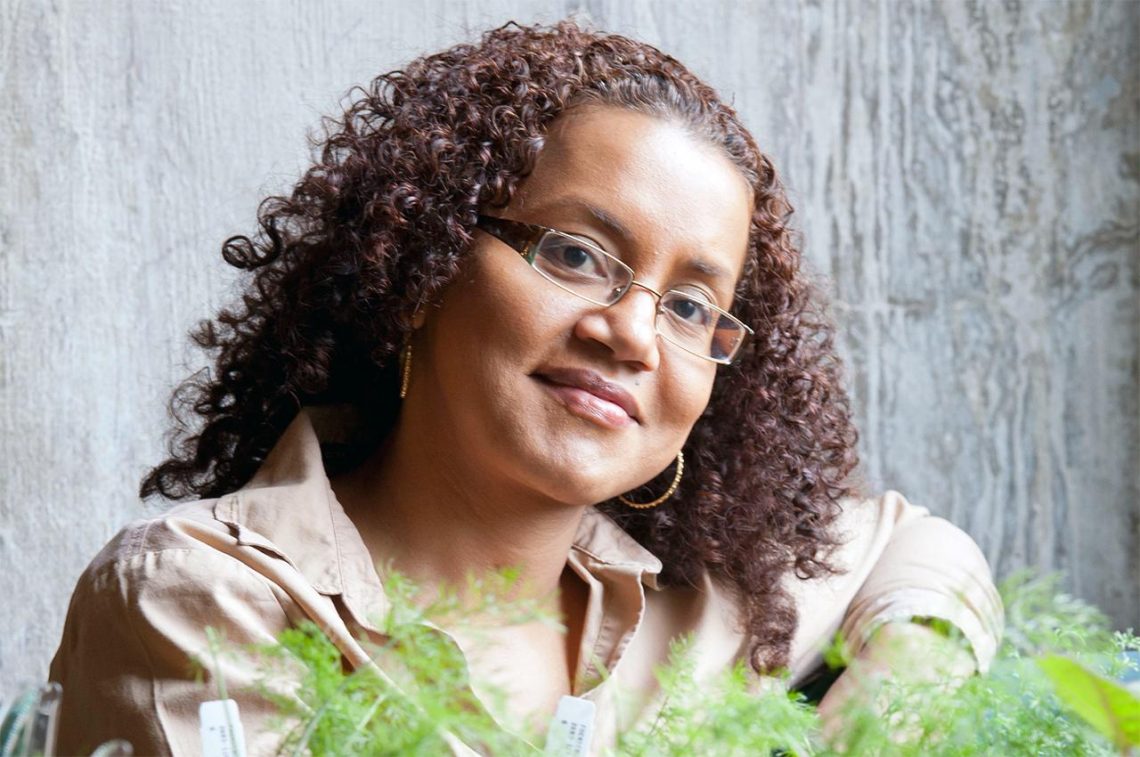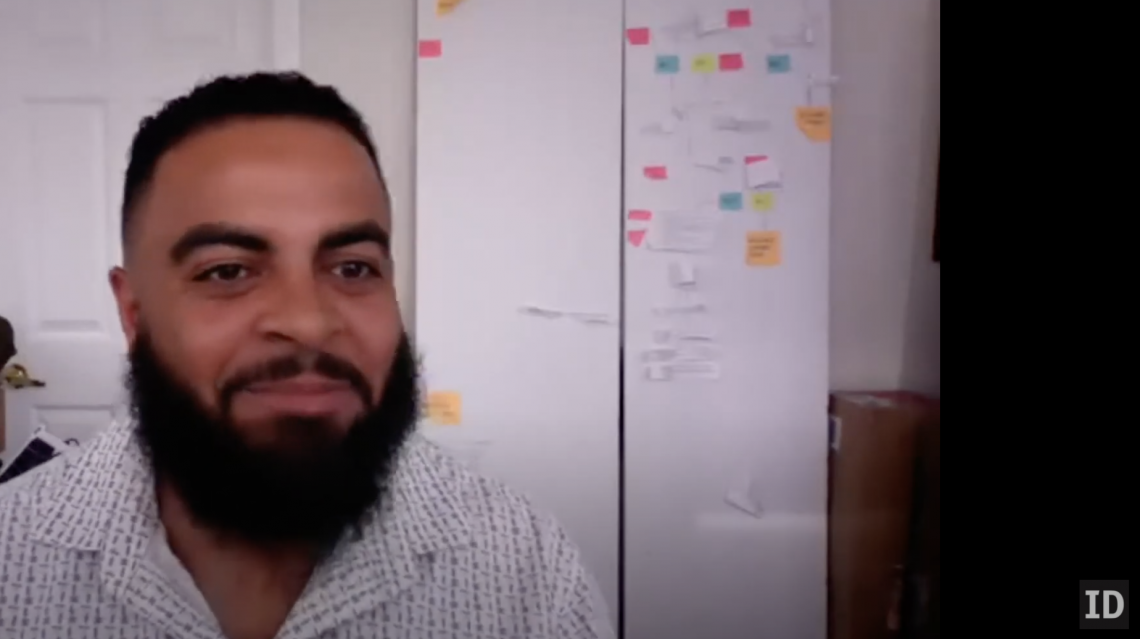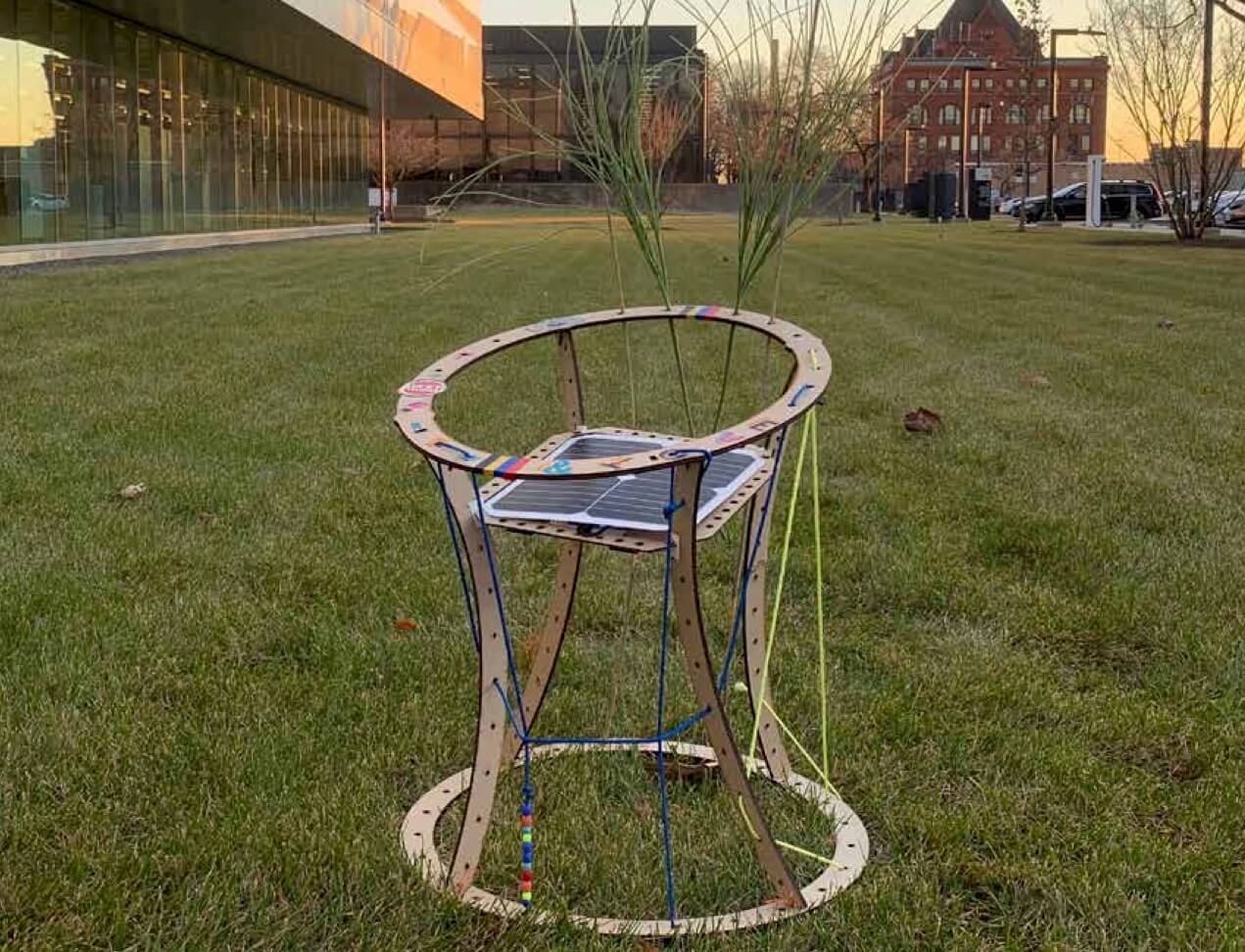Weslynne Ashton on Teaching Design and Business in the Current Moment
October 22, 2020

Working across industrial ecology, business, and design, Dr. Weslynne Ashton is the newest faculty member at IIT Institute of Design. Her work focuses on shifting socio-ecological systems towards sustainability and equity.
In this interview, Ashton speaks with ID student Audrey Gordon (MDes 2020) about building equitable circular economies, rectifying racial injustice, and designing for our changing climate. This conversation has been edited for length and clarity.
What first drew you to working in sustainability?
The field that I do my work in is called industrial ecology, which essentially takes the natural system, ecosystems, as a metaphor for how human industry ought to be organized in order to be more in balance with nature. I think we have this worldview that human systems are somehow separate from nature, and then that we extract what resources we need and dump the waste that we don’t. And that we can extract without limit and dump without limit. More and more in the last 30 to 50 years, we’re seeing that that’s not the case. And I think we now have global consciousness about that not being the case.
Industrial ecology really applies natural science, engineering, and social science tools to understand the relationship between resource extraction, conversion of materials, and their impacts on the environment. We do this to develop strategies, designs, and ways to think of how to reduce those impacts, use resources more effectively, and in some regard move away from this very linear model of extraction, processing, waste disposal to this more cyclic and circular economy where we are circulating resources and using them more effectively.
I have heard you on the SustainaBold Podcast talk about how part of your work is helping communities in the Global South avoid the mistakes of the Global North. And you have even compared Chicago to having aspects of both the Global North and the South. Can you say more about that?
I grew up in the Caribbean, and my outlook is shaped by that part of the world. Coming to Chicago, as a Black woman, the North-South divide was just obvious to me. There are published reports. It’s easy to see that Chicago is a very segregated city. Perhaps when you’re a member of the ethnic majority, perhaps it’s not something that you think about because you’re not as affected. But if you are a member of one of these minority groups, then it’s a bit more in your face.
I remember having a class a couple of years ago in Stuart [School of Business]. I teach a course in Social Entrepreneurship. And I had a couple students from Eastern Europe just expressed a discomfort with going south of 35th Street when we did a field trip to the South Side [of Chicago] and off the IIT island. That really struck me. I was like, “Wow, we’re telling these young people who are coming from other parts of the US and other parts of the world not to engage with this community, that this is dangerous.” And then those students internalize that [racism] and have this discomfort, not wanting to go past or to engage with these communities, and that’s really perpetuating stereotypes and biases.
I see one of the roles that I have is just helping students to confront those biases and expose them to the variety of life in Chicago. And when I see the city, I see the segregation — that the South Side is predominantly African American. The Southwest Side is predominantly Latinx. And on the North Side, we have all of this development. And from the [Mayor Rahm] Emanuel administration now through the [Mayor Lori] Lightfoot administration, all of the investment happens downtown. It happens on the North Side. And Black and Brown communities are disinvested.
And here we are a university that sits on the South Side. I think a lot about: what are ways that we can contribute to improving — through research, through practice — the lives of people living on the South and West sides of the city? And I think about this in much the same way that I think about work in other parts of the world that that are also disinvested.
It’s unfortunate that many systems create these inequitable outcomes. You have spoken previously about how we can use circular economies to make sure benefits are more equitably distributed across communities. Can you speak a bit more about that?
Circular economy—the term has been around for decades, but it’s only within the last 10 years that it’s really gained a lot of traction within business and policy realms. It’s seen as this very tangible way for businesses to move towards sustainability because of the focus on materials and resources.
In that regard, environmental issues have gotten a lot more traction from companies than social issues. Social issues were seen as more, “OK, we’re being socially responsible. We’re going to make these donations. We’re going to volunteer our time.” But it’s not really material and critical to the business, to the core competencies of the business. I think there have been shifts. There are a lot of companies that are thinking more strategically about their social responsibility and creating shared value with communities.
I am encouraged that I am hearing more discussion about equity and justice coming into the circular economy discourse. But it still feels like a bit on the fringe because it’s being led by corporate actors and policymakers. It’s very much “OK, how can we utilize these resources more efficiently so that we get a win-win?” That is, so that there’s an economic win as well as an environmental win, and the social dimension is not as prominent. In my work, what we’re trying to do now is to try to quantify the value of social capital and human capital and how that contributes to a circular economy.
I can draw it back to looking at different communities and which communities are invested in. And we see a lot of circular economy activity happening in Europe and in China, but there are important initiatives that are happening in Sub-Saharan Africa. Rwanda is a great example of a country that is really thinking hard about its sustainability and applying circular economy principles to the organization of the economy. I think there are many opportunities, and already the beginnings of policies being shaped by governments in the Global South.
One other thing that I’d like to mention is—I guess this is now two years ago—I participated in a program that’s run by the National Academy of Sciences, Engineering, and Medicine. I was selected as a Jefferson Science Fellow with an appointment at the US Agency for International Development. And the idea there is calling knowledge from academia and plugging it into government agencies that deal with international policy and development. And so I’m speaking on a panel next week about circular economy and engaging the private sector in the Middle East around the circular economy. I feel like there are lots of opportunities that are being tapped into now that really connect the needs of the Global South for a development path that uses resources wisely. And, as you said, doesn’t repeat some of the mistakes of the linear economy.
You mentioned that you are looking for ways to incorporate humility, authenticity, and decolonization within your work. I would love to hear about that.
This is really personal. Again, I think part of it is who I am as a Black woman that was raised in the Caribbean having a very British postcolonial educational experience. One of the leading scholars in Trinidad [Prof. Lloyd Best] coined the term “Afro-Saxons.” We are African-descended people who are raised with a British Anglo-Saxon worldview that shaped our thinking about what’s important, the development paths that we undertake. And so when I think about how I think, it’s very Afro-Saxon. It’s mainly Western, European, British with some sprinklings of African, indigenous, Indian threads of culture and values, but those are relegated to the fringes. Where this really hit me was when I first worked in Hawaii about 12 years ago. I was really struck by Native Hawaiian indigenous culture. Even though Hawaii has been colonized by the US, and there is a dominant white American set of values, European-American values, Native Hawaiian culture has been preserved. And there are land management practices, there are family structures that are really intact much more so than they are in the Caribbean. Seeing this just made me realize that there’s so much to learn, and there’s so much value in indigenous cultures that have been steamrolled by the discourse of westernization, modernization, and development.
In all the work that I’ve done since, I try to come into situations from a position of humility and wanting to learn. And using the tools that I have to support the needs and the aspirations of the communities that I that I work with. I think that about any conversation that I enter with a group that I’m not a part of — that I need to listen and learn. And I feel like this is so important in the work of design, the work of sustainability. No one person knows everything. We all have different sets of expertise that we can try to interject into a situation, but it’s really important to have a diversity of knowledge. And recognize that.
Now to bring this back to authenticity and bringing your whole self to a conversation. This reminds me of a conversation that that I was involved with, with a group of Black and Brown farmers primarily in Chicago and Cook County. I’m coming in as an academic, as an outsider. And for most of the call, I’m listening rather than interjecting. But one of the things that was raised was this idea of whole people. So often when you meet someone in a particular context, you only see that one particular side of them and don’t know all of the other dimensions of who they are. [emotional pause]
I’m very here for this conversation.
And right now in America, it’s hard being a Black professional. We didn’t talk about this in class yesterday. About the fact that there have been protests over the last three months about police brutality. About the fact that Black lives don’t matter in this country. And I didn’t bring that to the conversation because in the context that we’re in, we’re there for a particular reason. We have a limited amount of time. We need to be on the same page and create our vision and create our goals for the class. But now, more and more, I’m appreciating this moment for giving me the freedom to — not giving me the freedom but creating the space — that allows me to bring more of those concerns into more professional conversations.
I think that back in June, July, we were all talking about COVID. The protests were happening. And some universities were making statements. And it’s like, “Well, what are we doing? What are we saying? Do we care? Does this matter to us?” I worry about being labeled as “an angry Black woman,” but I am using the shield of my position as a tenured faculty member now to say what’s on my mind, to say things that rock the boat, make people uncomfortable, and bring into conversations viewpoints that are neglected.
I also want to make it clear that I recognize my privilege as a Black person who was not raised in this country and did not face the institutionalized racism that most African Americans do face. But that my children will face because they’re being raised here. I recognize my privilege. I see the importance of raising issues that are uncomfortable to use that privilege for. But increasingly I’m thinking about how to be more authentic. To bring these uncomfortable positions. To bring conversations that are perhaps not obvious and might be seen as out of context into spaces where they matter because we need it for systems change.
Absolutely. And perhaps some of that is part of decolonization. If we really want to dismantle colonialism, having the space and time for these conversations is important. There is already a strong community within the school [ID] having these conversations and eager to have more. At least from my perspective, I would be very open to those kind of conversations in class. It’s very important.
Yeah, so we’ll talk about it. We’ll make that space. Just another anecdote to this point. During COVID, when we switched into the online mode, I spent half of one of my classes just talking about how people are feeling and what’s going on. Frustrations and inspirations and making a space for our community. Education is evolving, right? Part of higher education and graduate school is yes, we have these tools for you to learn and how to apply them. But it’s also about the network and the relationships that you have with people. And these more authentic conversations are really needed for people to expose their vulnerabilities and share and learn together.
I feel like I have always been odd as a professor in terms of exposing my weaknesses and vulnerability. And I recognize the privilege that I teach graduate students who are more mature. Because I’ve heard stories, read the publications that typically faculty of color, women faculty, queer faculty are typically unable to expose, to make themselves vulnerable in more of the undergraduate settings because they’re killed in evaluations because of who they are. I am appreciative that teaching in graduate programs [at Illinois Tech] gives me the space to share my vulnerabilities with my students and not be penalized for it. I’ll leave that there [laughs].
I think it also speaks to the mental model of what education is. What role do professors and students play? Undergrad is often top down — the teacher is there to impart knowledge. But in graduate school, and particularly at ID, there is less of that. It’s more, “We are all here together and have experiences to share.”
Let’s close on your new class at ID. I am personally very excited to take Design for a Changing Climate. I’m curious if you could talk a bit about what you plan to teach and what you would like all designers to know about this topic.
In doing my course prep for this year and making the switch to ID, I do see that most of my classes have had a similar structure. There is science. There is design. There is management. And that design and management can be in a business context, it can be in a policy context, or some sort of strategic/design/community focus context. This is a short course, and this is my first time teaching seven-week classes which is fun.
But they’re very quick [laughs].
I have a lot to try to get in. My plan is that we will talk about the science and what is known. How do earth system scientists and climatologists make forecasts and model the climate and future changes? I think understanding the science is really important. It’s a key part even if you’re not a scientist, but you are designing with scientists. Understand what they’re doing, so you’re more effective in that conversation.
There will also be a portion where we examine how design is contributing to climate change. How are the products, the business models that have been designed over the last century contributing to fossil fuel consumption, plastics, waste generation, and emissions? We talk about mitigation and adaption as key strategies for us moving forward. How do we design for reducing emissions and trying to reduce the impacts of climate change? I think we’re at a point where climate change is happening. We are seeing it right now. Already all around us. How do we adapt and build solutions with communities that can help to ease the burden of the impacts? And so that might be product design. It might be infrastructure design.
Since this is the first time that that I’m teaching this, I see this as really being an exploration. What are the important lessons or takeaways for designers? I think an important question is going to be: how is what you’re designing contributing to climate change? And what are our plans to alter those designs so that they either reduce the impacts or help to adapt, so that they help people to be shielded or feel the impacts less on their ways of living. So still in development [laughs].
I do appreciate the emphasis of “let’s talk about the science, and let’s really understand.” Designers are so often in this translation role. You need to speak to many people. If you do not have a base understanding of where people are coming from it makes filling your role as a designer so much more difficult.
Originally published at Medium.com.


